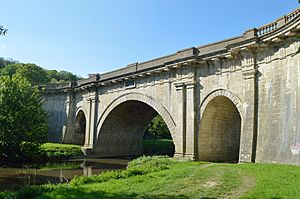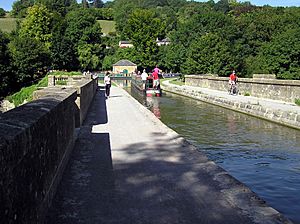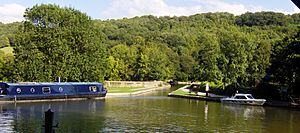Dundas Aqueduct facts for kids
Quick facts for kids Dundas Aqueduct |
|
|---|---|
 |
|
| Coordinates | 51°21′42″N 2°18′38″W / 51.3616°N 2.3105°W |
| OS grid reference | |
| Carries | Kennet and Avon Canal |
| Crosses | River Avon & Wessex Main Line |
| Locale | Limpley Stoke |
| Maintained by | Canal & River Trust |
| Heritage status | Grade I |
| Characteristics | |
| Pier construction | Bath Stone |
| Total length | 150 yards (137.2 m) |
| Longest span | 65 feet (19.8 m) |
| History | |
| Designer | John Rennie |
| Construction begin | 1797 |
| Construction end | 1801 |
| Opened | 1805 |
| Rebuilt | 1984 |
The Dundas Aqueduct is a special bridge that carries the Kennet and Avon Canal over the River Avon. It also crosses over the Wessex Main Line railway. You can find it near Monkton Combe, Somerset, about 4 kilometers (2.5 miles) southeast of Bath.
This amazing structure was designed by John Rennie and John Thomas. Construction started in 1797 and finished in 1801, but it wasn't fully open until 1805. It is named after Charles Dundas, who was the first chairman of the Kennet and Avon Canal Company.
Contents
Building the Aqueduct
The Dundas Aqueduct is about 137 meters (150 yards) long. It has three arches and is built from Bath Stone. The design includes Doric pilasters, which are like decorative columns, and balustrades (fancy railings) at each end.
The middle arch is semi-circular and spans about 19.5 meters (64 feet). The two arches on the sides are oval-shaped and span about 6 meters (20 feet) each.
Why it was Built
The canal needed to cross the River Avon and the railway. This aqueduct helped the canal avoid the steep sides of the river valley near Limpley Stoke. It also meant the canal didn't have to cross other rivers like the Midford Brook and the River Frome.
The canal actually crosses the Avon and the railway again on another aqueduct called Avoncliff.
A Protected Landmark
The Dundas Aqueduct is a very important historical structure. It is a Grade I listed building, which means it's considered to be of exceptional interest. In 1951, it became the first canal structure to be named a Scheduled Ancient Monument. This protects it for future generations.
Restoration and Reopening
Over many years, the aqueduct started to leak. Because of this, it was closed in 1954. For a while in the 1960s and 1970s, the canal was dry in this area. You could even walk along the empty canal bed and through the aqueduct itself!
In 1984, the aqueduct was repaired and reopened. Workers carefully lined it with polythene and concrete. They also made sure not to disturb a group of bats that lived under the aqueduct.
Between 2002 and 2004, more restoration work was done. This included replacing some newer bricks with Bath Stone to match the original look of the aqueduct.
Canal Connections

The aqueduct is also where the Kennet and Avon Canal meets the Somerset Coal Canal. Most of the Somerset Coal Canal is no longer used, but a short part of it is still filled with water. This section forms Brassknocker Basin.
Brassknocker Basin is a busy spot. It's used for boat moorings, where boats can tie up, and you can even rent bikes there. There's also a cafe. Next to it is Dundas Wharf, where an old tollhouse, a warehouse, and a crane still stand.
Railway Changes
In 2015, the railway tracks below the aqueduct were lowered. This was done so that the route could be used in the future as a different path for freight trains. Network Rail even shared a video showing this work being done.
See also
 In Spanish: Acueducto Dundas para niños
In Spanish: Acueducto Dundas para niños


